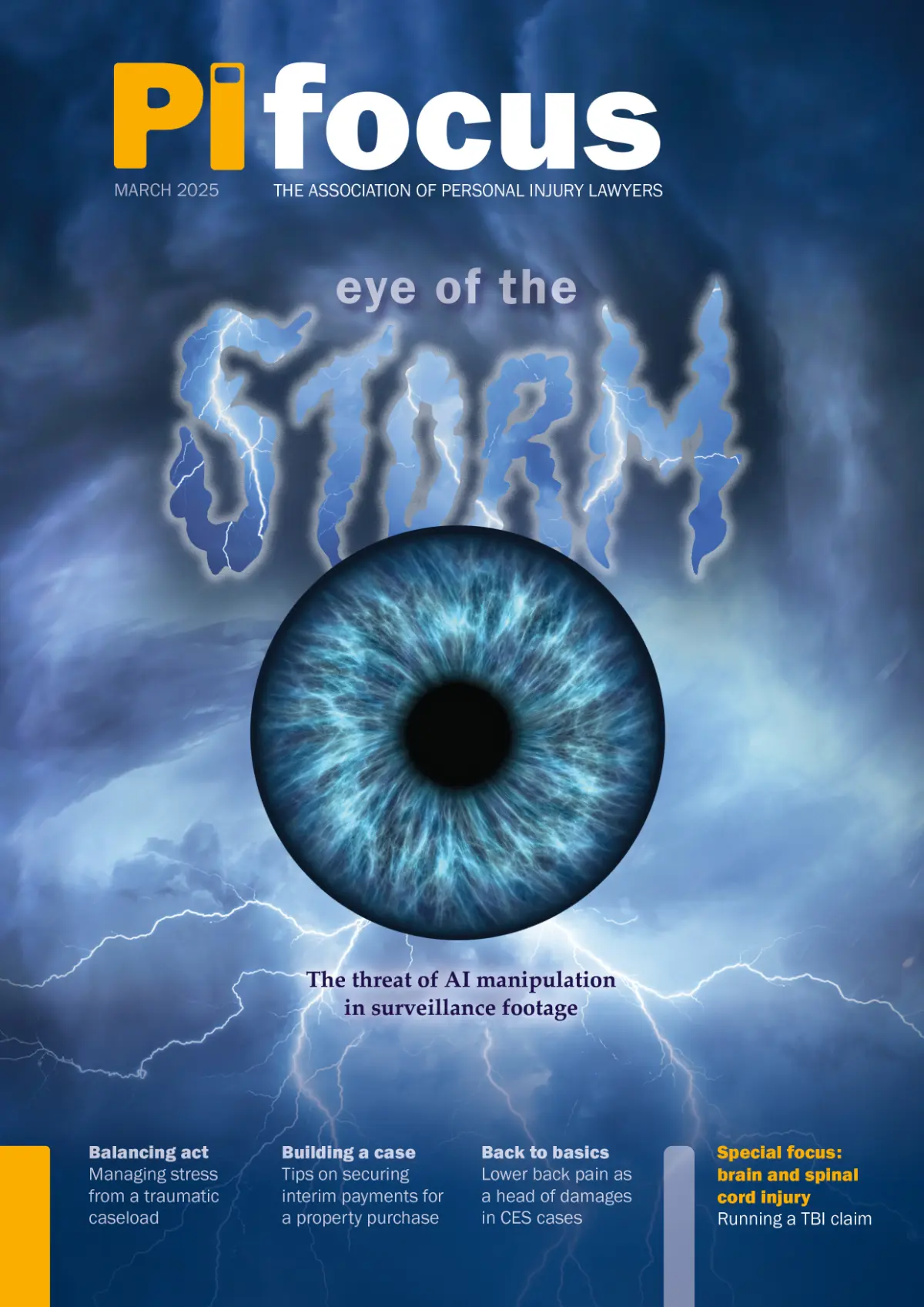An article by Jeff Simm of Lumina Surveillance Group
Great cover story by Jeff Simm Director of Surveillance at Lumina in last month’s edition of PI Focus discussing the threat of video manipulation and the risk AI is having in evidence distortion
Covert surveillance evidence has always provoked strong opinion.
On the one hand, it is an invaluable tool in determining the true facts in high-value personal injury and medical negligence claims.
On the other hand, it can be deemed an intrusion into a person’s life and movements which can be distressing if discovered at the time of the surveillance, or when delivered by the claimant’s lawyers.
If, however, the surveillance is carried out correctly and delivered with absolute Data Verified Integrity, then all parties – regardless of whom the footage benefits – should be able to accept it and subsequently work collaboratively to conclude the case.
For all parties, knowing that the video evidence on the table can be relied on saves time, money, stress and reputation; and although it may not seem it at the time, it is to the benefit of all parties tasked with progressing the matter, however the claim may subsequently settle.
Good behaviour
There are some highly professional surveillance companies in the UK which dispatch professionally trained operatives equipped with the latest covert cameras, vehicles and equipment to ensure that the entirety of the picture is captured. The evidence they gather is processed with digital evidence trail records and delivered without prejudice, allowing their instructing clients to assess the case fully and reliably informed.
They can absolutely rely on the evidence, not just the footage that purports to show the subject’s movements, but the entirety of the whole evidence train, from pre-surveillance checks, operative accountability, evidence processing, evidence duplication for distribution and ultimately, if required, giving evidence in court.
These surveillance companies also adopt strict internal protocols to ensure that the service they provide is repeatedly delivered to the same high standards. They cannot guarantee to obtain film each and every time, as on occasion the subject of the surveillance may not move, but they are able to deliver an accurate and verified account of exactly what took place during the monitoring of the subject.
Bad behaviour
Issues with video evidence arise when the evidence gathered is not an accurate account of what took place, when under-pressure surveillance operatives, bound by monetary or job security incentives, are self-steered to manufacture or manipulate the film.
Unreliable video evidence is counterproductive for all parties. There was a time when deliberately manipulated video evidence routinely slipped through the net, when the general consensus was that ‘The camera never lies’. But that changed a decade or so ago, when a number of cases became publicly high profile due to the unearthing of deliberately manipulated footage presented as unedited.
One case proceeded all the way to the morning steps of the Royal Courts of Justice in London.
I have previously written about the ‘rogue’ element of the covert surveillance industry (see PI Focus, September 2018, page 8); a cloak and dagger element which embarrassingly for the industry, a small number of operatives still choose and at times seem almost compelled to operate under.
Through highlighting issues and the subsequent number of high-profile and reported cases, the legal profession, both claimant and defendant, is now alive to the tactics that some rogue operatives choose to deploy. But sadly, rather than cleaning up their acts, some surveillance operatives or those instructing them have chosen instead to seek out ever more ingenious methods of discreetly but fundamentally altering potentially crucial footage.
Licensing of the industry might have helped, and was proposed by the then Home Secretary Theresa May back in 2013. In proposing government legislation, she said:
‘Operating as an unlicensed private investigator will become a criminal offence. The current arrangements, under which the system is not regulated, allows anyone to work as a private investigator, regardless of their skills, experience or criminal convictions. This presents a high risk of rogue investigators unlawfully infringing on the privacy of individuals.’
Unfortunately, licensing did not come to fruition, and so here in 2025, the industry remains unregulated.
Trade body The Association of British Investigators publicly pushes for regulation, but even it is aware of the issues among members and non-members alike. It says on its website:
‘While we wait, the industry remains a “free-for-all”, where untrained and unscrupulous operators are free to practice’.
Collaborative working
Some forward-thinking claimant and defendant lawyers have begun working collaboratively. On both parties accepting that the video evidence is reliable, they have then been able to conclude the case proportionately, negating the need to lock the traditional horns.
However, to work collaboratively, all parties need to know that the often case-determining video evidence is authentic, reliable and free from any sort of manipulation, whether that be innocent or malicious.
Recently I have been involved in a number of cases that have contained a worrying new element to the video evidence, and that is artificial intelligence.
Artificial intelligence
Coupled with post capture editing / manipulation and selective filming methods, artificial intelligence can add an almost undetectable element to presented video evidence.
It used to be that subtly speeding up footage could mask the true content of a specific section of film, usually to hide gait or other subtle fluidity of movement issues. But artificial intelligence can alter things much more comprehensively, and if the original recording media has not been retained or working copies of the evidence electronically verified, then it is almost impossible to uncover artificially manipulated film.
Further, it is not always the case that artificial intelligence has been used maliciously. Not all video evidence comes from the lens of the camera of the surveillance operative. Social media footage/postings can often have a determining impact, and while such recordings can be maliciously manipulated post capture, they are often also subtly modified automatically by the camera or application with which the film is taken.
This can prove pivotal if the footage is being used to determine, say, an accident victim’s position within a vehicle, or context relating to distance when footage is captured via a dash cam.
Continued on P27
JEFF SIMM EXAMINES THE NEW THREAT POSED BY ARTIFICIAL INTELLIGENCE IN SURVEILLANCE FOOTAGE
For all parties, knowing that the video evidence on the table can be relied on saves time, money, stress and reputation
There was a time when deliberately manipulated video evidence routinely slipped through the net
Unfortunately licensing did not come to fruition and so the industry remains unregulated
Some forward-thinking claimant and defendant lawyers have begun working collaboratively
Artificial intelligence can add an almost undetectable element to presented video evidence
Subtly speeding up footage could mask the true content of a specific section of film, usually to hide gait
We recently carried out an exercise to demonstrate how applications embedded within a modern smart phone can innocently yet fundamentally alter the perspective of a photograph or video.
We positioned three distinctly dressed people in the rear of a vehicle, and placed a large ‘R’ over the right eye of the person sat in the middle seat. We then photographed/videoed the three using the regular camera on the back of a modern smart phone (see image, top right). Keeping them in the same positions, we then photographed/videoed them through the Snapchat application using the ‘selfie’ camera of the same phone (see image, bottom right), to highlight that the positions of the occupants then changes.
This automated, non-malicious manipulation of the film is obvious when using three distinctly dressed individuals and identification markers. But it is clear how, to the untrained eye and perhaps in not such a clean-cut environment, footage such as this could easily steer an expert or a court to form or change their opinion.
Artificial intelligence is extremely fast paced. Advances in artificial voice intelligence, for example, have already had me thirty seconds or so into an unsolicited marketing cold call before I realised I was not speaking with a person. Video artificial intelligence used to be a step behind, but is now right at the forefront. It is truly worrying how this might in the future be the new post capture editing choice for rogue surveillance operatives still forced or choosing to operate under ‘no film no fee’ or bonus-incentivised film-type instruction.
Verifying integrity
Going full circle, it is actually computer technology that can be used to verify the integrity and authenticity of presented video evidence. Whether instructing or receiving video evidence, such verification – along with confirmation that the original recording media has been retained – is the only absolutely guaranteed method of knowing that the presented evidence is what it purports to be.
Whether claimant or defendant, receiving or instructing video evidence or relying on smart camera or social media footage, the same thought process should be applied:
Is it original?
‘Original’ should mean the original recordings, captured on virgin recording media SD Cards if relating to footage obtained by a surveillance operative, or original as in held within the original recording device ie. mobile phone. SD Cards and recording devices hold meta data (data about data) and this can be retrieved and examined to determine beyond any doubt if the footage has been accessed and / or manipulated post capture. Such data often also contains information about where the footage was taken, which can further serve to strengthen its authenticity, and by proxy the reliance that can be absolutely placed upon it.
Is it reliable?
‘The camera never lies’ is the old saying, but all too often it does. Evidence should always be original, but reliance can be further added by the presence of computer generated and personnel evidence trails. This is particularly the case when multiple ‘working’ copies are being used by the courts and experts from other fields to form or amend their opinions.
It is often difficult to identify if film has been manipulated post capture, and with AI on the increase, then it seems it is only going to become more difficult. Whether claimant or defendant (peer review) instructed, a fairly straightforward and cost effective initial analysis review will highlight if caution needs to be exercised or further analysis warranted.
Can its integrity be proven?
Know who has carried out the surveillance and check that strict procedures with regards gathering, storing, processing and sharing the evidence have or are being adhered to every single time that video evidence is being considered to prove or progress a case.
If you choose to advance your case while disregarding these factors, then it is at great risk of case outcome, financial and reputational damage.
Jeffrey Simm is a covert surveillance and video evidence analysis expert at Lumina Surveillance Group

